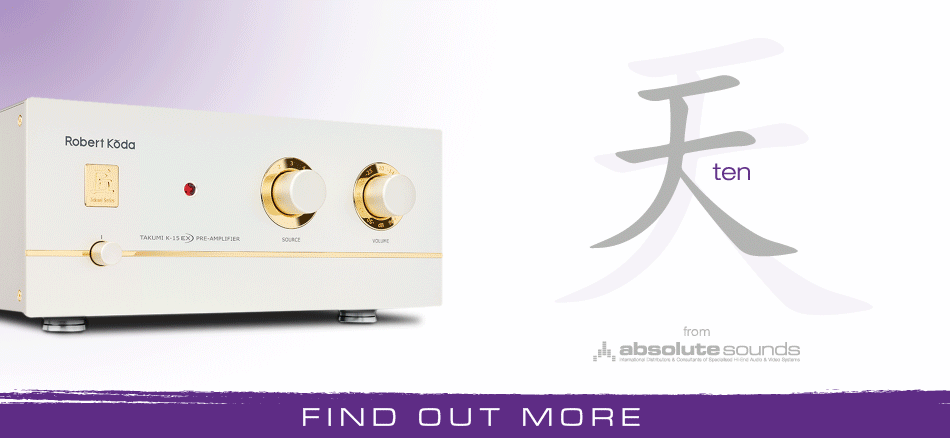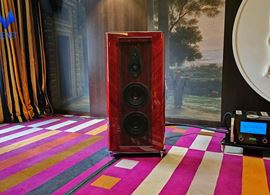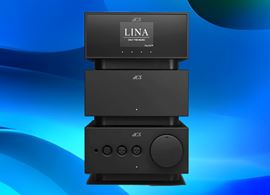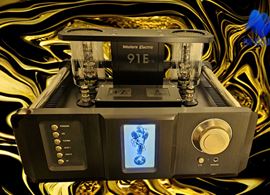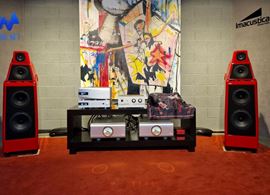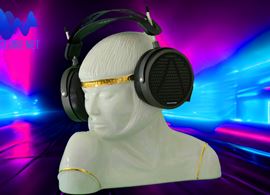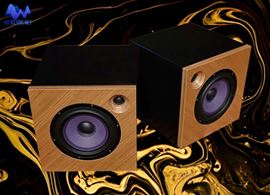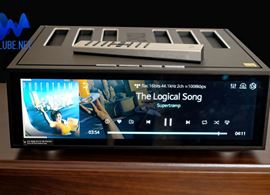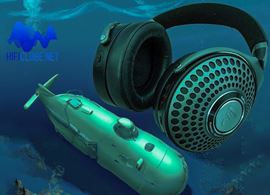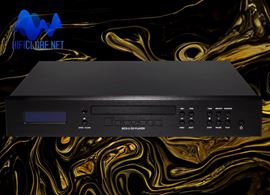CLOCK
Q:
Does DAC64 have its own master clock? What type of clock do you use?
Rob answers:
It's a high quality crystal clock with its own buffer and PSU.
Q:
Why then does it stop playing whenever you pull the transport plug from the mains, although it sometimes keeps playing when you just open the drawer?
Does it rely on the transport clock or not?
Rob answers:
When you switch off the transport, digital lock is lost, the outputs are immediately muted via a shorting relay. The transport clock is only used to increment the write pointer into the RAM. All circuitry post RAM is clocked by the DAC clock.
Q:
Is the crystal oscillator at the output of the FIFO powered by the same power supply that powers the input of the FIFO?
Rob answers:
It uses the PSU for the receiver section. The filter, DAC and analogue all have separate regulated supplies. The input to the filter section is re-synched to remove receiver PSU induced jitter. The PSU is vital, I have always used separate regulators for the clocks. It makes a tremendous difference.
WTA FILTER
Q:
Which is more important in relative order: RAM buffer, WTA filter, DAC?…
Rob answers:
The important factors are the WTA filter, the noise shaper
design, pulse array DAC, analogue OP stages, jitter, RF noise, 64 bit, plus other details that is only available when you design at the gate level. Of all of them, the WTA filter is probably the most important.
CABLES
Q:
Does the RAM memory make the sonic differences between interface technologies such as Toslink, S/PDIF and AES-EBU irrelevant? Is the DAC64 more or less sensitive to the quality of the transport and digital cable when compared to other DACs? Which is the best connection for the DAC64: AES/EBU, S/PDIF or Toslink optical?
Rob answers:
Optical. The DAC is still sensitive to the amount of RF noise the transport generates. But when using optical, it is very consistent. Moreover, analogue electronics are also sensitive to the noise the transport generates...
BUFFER LENGTH
Q: On the DAC 64' review one can find at Chord's website you are quoted as
stating that no (audible, I assume) differences should be found among the
buffer lenghts available:«Curiously, from Rob Watts' own mouth, there really should be no
difference between the two buffer lengths(...)»
I find this statement (if you are correctly quoted) quite puzzling.
Indeed, if no differences were expected, why offering several buffer
lenghts? Everybody claims that the differences are clear ...
And why 2 and 4 seconds? how much could you benefit from a bigger
buffering time (I know this would not be user friendly ...)? What would
you loose by reducing the buffering time ?
So, the bottom line is: what is the DAC 64 doing with incoming data
during the buffering time? Is this time slot used to reduce random jitter?
Rob answers:
There is no difference between 1 sec and 4 sec delay once data is
running - its exactly the same circuitry doing exactly the same. Using
optical, I can't hear a difference between the two settings.
The reason I give 1 and 4 seconds is the only time you get that is
guaranteed 8 seconds of silence is when you are changing discs. So you can have 72 minutes of playing a CD where the pointers are completely separate.
If the clock on the transport is low quality and not accurate, the 1 second delay can drift to so that there is no delay - then suddenly 8 seconds! So we give the option for poor accuracy transport clocks. The vast majority of hi-end transports are accurate enough for 1 second.
PHASE INVERSION
Q:
Why does DAC64 invert phase? Do you think absolute polarity is important
or is it just a 50/50 chance to get it right?
Rob answers:
The Chord power amps invert phase, so this is to match them. You can use the
XLR OP, as they are gnd ref and offer in phase and out of phase OP, so use
them single ended with a phono. Personally, I think it's a 50/50 chance anyway. I have only been able to hear the difference of abs phase with panel speakers, and even then it is not a
huge change. A lot of phase inversion switches themselves change the sound,
so most of the time people are hearing the switches!
POWER SUPPLY
Q:
Does DAC64 use a linear or switched PSU?
Rob answers:
The first pre-production had linear PSU, the rest had switchers. The
current switcher dual BNC sounds better than the pre-production.
MULTIBIT VS BITSTREAM
Q:
Is DAC64 a bitstream or multibit DAC?
Rob answers:
I do not think there are any true multibit (i.e. R2R ladder type) DAC's available today. All use noise shapers, and they are either single bit OP (PDM or bitstream types) or multibit. The multibit has a number of different strategies - pulse array is a multibit type, but has the advantages of bitstream (perfect low-level linearity), but none of the disadvantages (poor resolution and high level distortion and compression). Pulse array doers not suffer at all from the high level modulation problems of bitstream, and it does not suffer from the poorer low-level distortion of conventional multibit.
Q:
Does DAC64 have its own master clock? What type of clock do you use?
Rob answers:
It's a high quality crystal clock with its own buffer and PSU.
Q:
Why then does it stop playing whenever you pull the transport plug from the mains, although it sometimes keeps playing when you just open the drawer?
Does it rely on the transport clock or not?
Rob answers:
When you switch off the transport, digital lock is lost, the outputs are immediately muted via a shorting relay. The transport clock is only used to increment the write pointer into the RAM. All circuitry post RAM is clocked by the DAC clock.
Q:
Is the crystal oscillator at the output of the FIFO powered by the same power supply that powers the input of the FIFO?
Rob answers:
It uses the PSU for the receiver section. The filter, DAC and analogue all have separate regulated supplies. The input to the filter section is re-synched to remove receiver PSU induced jitter. The PSU is vital, I have always used separate regulators for the clocks. It makes a tremendous difference.
WTA FILTER
Q:
Which is more important in relative order: RAM buffer, WTA filter, DAC?…
Rob answers:
The important factors are the WTA filter, the noise shaper
design, pulse array DAC, analogue OP stages, jitter, RF noise, 64 bit, plus other details that is only available when you design at the gate level. Of all of them, the WTA filter is probably the most important.
CABLES
Q:
Does the RAM memory make the sonic differences between interface technologies such as Toslink, S/PDIF and AES-EBU irrelevant? Is the DAC64 more or less sensitive to the quality of the transport and digital cable when compared to other DACs? Which is the best connection for the DAC64: AES/EBU, S/PDIF or Toslink optical?
Rob answers:
Optical. The DAC is still sensitive to the amount of RF noise the transport generates. But when using optical, it is very consistent. Moreover, analogue electronics are also sensitive to the noise the transport generates...
BUFFER LENGTH
Q: On the DAC 64' review one can find at Chord's website you are quoted as
stating that no (audible, I assume) differences should be found among the
buffer lenghts available:«Curiously, from Rob Watts' own mouth, there really should be no
difference between the two buffer lengths(...)»
I find this statement (if you are correctly quoted) quite puzzling.
Indeed, if no differences were expected, why offering several buffer
lenghts? Everybody claims that the differences are clear ...
And why 2 and 4 seconds? how much could you benefit from a bigger
buffering time (I know this would not be user friendly ...)? What would
you loose by reducing the buffering time ?
So, the bottom line is: what is the DAC 64 doing with incoming data
during the buffering time? Is this time slot used to reduce random jitter?
Rob answers:
There is no difference between 1 sec and 4 sec delay once data is
running - its exactly the same circuitry doing exactly the same. Using
optical, I can't hear a difference between the two settings.
The reason I give 1 and 4 seconds is the only time you get that is
guaranteed 8 seconds of silence is when you are changing discs. So you can have 72 minutes of playing a CD where the pointers are completely separate.
If the clock on the transport is low quality and not accurate, the 1 second delay can drift to so that there is no delay - then suddenly 8 seconds! So we give the option for poor accuracy transport clocks. The vast majority of hi-end transports are accurate enough for 1 second.
PHASE INVERSION
Q:
Why does DAC64 invert phase? Do you think absolute polarity is important
or is it just a 50/50 chance to get it right?
Rob answers:
The Chord power amps invert phase, so this is to match them. You can use the
XLR OP, as they are gnd ref and offer in phase and out of phase OP, so use
them single ended with a phono. Personally, I think it's a 50/50 chance anyway. I have only been able to hear the difference of abs phase with panel speakers, and even then it is not a
huge change. A lot of phase inversion switches themselves change the sound,
so most of the time people are hearing the switches!
POWER SUPPLY
Q:
Does DAC64 use a linear or switched PSU?
Rob answers:
The first pre-production had linear PSU, the rest had switchers. The
current switcher dual BNC sounds better than the pre-production.
MULTIBIT VS BITSTREAM
Q:
Is DAC64 a bitstream or multibit DAC?
Rob answers:
I do not think there are any true multibit (i.e. R2R ladder type) DAC's available today. All use noise shapers, and they are either single bit OP (PDM or bitstream types) or multibit. The multibit has a number of different strategies - pulse array is a multibit type, but has the advantages of bitstream (perfect low-level linearity), but none of the disadvantages (poor resolution and high level distortion and compression). Pulse array doers not suffer at all from the high level modulation problems of bitstream, and it does not suffer from the poorer low-level distortion of conventional multibit.

